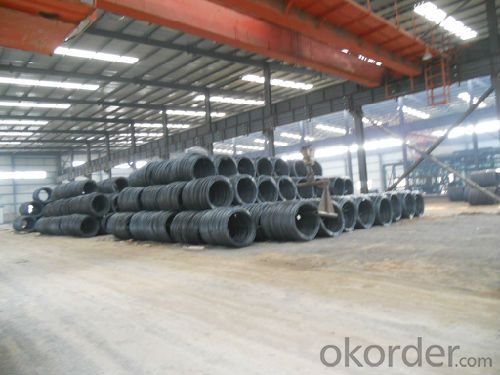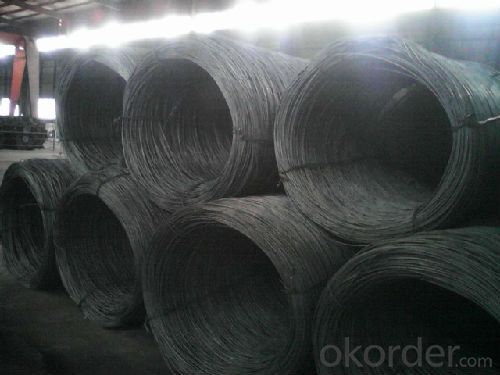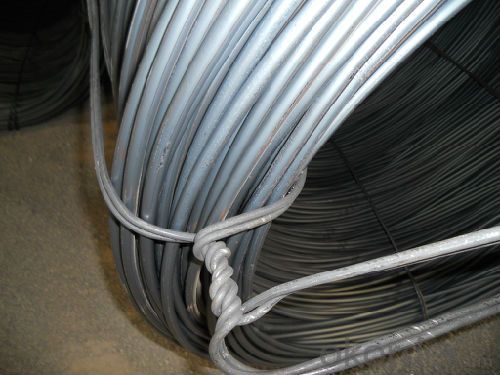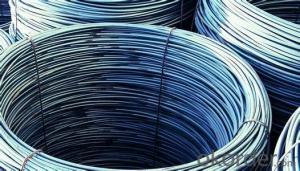Hot Rolled Steel Wire Rod steel SAE1008 SAE1018 for Construction
- Loading Port:
- Tianjin
- Payment Terms:
- TT or LC
- Min Order Qty:
- 1000 m.t.
- Supply Capability:
- 10000 m.t./month
OKorder Service Pledge
OKorder Financial Service
You Might Also Like
Product Description:
OKorder is offering Hot Rolled Steel Wire Rod steel SAE1008 SAE1018 for Construction at great prices with worldwide shipping. Our supplier is a world-class manufacturer of steel, with our products utilized the world over. OKorder annually supplies products to European, North American and Asian markets. We provide quotations within 24 hours of receiving an inquiry and guarantee competitive prices.
Product Applications:
Hot Rolled Steel Wire Rod steel SAE1008 SAE1018 for Construction are ideal for structural applications and are widely used in the construction of buildings and bridges, and the manufacturing, petrochemical, and transportation industries.
Product Advantages:
OKorder's Hot Rolled Steel Wire Rod steel SAE1008 SAE1018 for Construction are durable, strong, and resist corrosion.
Main Product Features:
· Premium quality
· Prompt delivery & seaworthy packing (30 days after receiving deposit)
· Corrosion resistance
· Can be recycled and reused
· Mill test certification
· Professional Service
· Competitive pricing
Product Specifications:
Steel Grade: Q195 Standard: ASTM, GB
Diameter: 5.5mm, 6.5mm, 7mm,8mm,9mm,10mm,12mm,14mm
6.5mm can be drawing into 2mm/8.0mm can be drawing into 3mm
Type: Drawn Wire in Coil, each coil weight about 2MT
Brand Name: N-RIVER Place of Origin: Hebei, China
Chemical Composition:
Please kindly find our chemistry of our material based on Q195 as below for your information
Trademark | Rank | Chemical composition (quality score) % | |||||
C | Si | Mn | S | P | |||
| ≤ |
| ≤ | ≤ | |||
Q195 |
| 0.06-0.12 | 0.30 | 0.25 | 0.050 | 0.045 | |
Trademark | Rank | Pulling Test | |||||
Bend PointΔs/Mpa | Tensile Strength | Elongation Ratioδ5% | |||||
Thickness (Diameter) /MM | Thickness (Diameter) /MM | ||||||
≤16 | 16-40 | ≤16 | 16-40 | ||||
≥ | ≥ | ||||||
Q195 |
| 195 | 185 | 315-390 | 33 | 32 | |
Packaging & Delivery of Hot Rolled wire rod Steel
1. Packing: it is nude packed in bundles by steel wire rod
2. Bundle weight: not more than 3.5MT for bulk vessel; less than 3 MT for container load
3. Marks:
Color marking: There will be color marking on both end of the bundle for the cargo delivered by bulk vessel. That makes it easily to distinguish at the destination port.
Tag mark: there will be tag mark tied up on the bundles. The information usually including supplier logo and name, product name, made in China, shipping marks and other information request by the customer.
If loading by container the marking is not needed, but we will prepare it as customer request.
4. Transportation: the goods are delivered by truck from mill to loading port, the maximum quantity can be loaded is around 40MTs by each truck. If the order quantity cannot reach the full truck loaded, the transportation cost per ton will be little higher than full load.
5. Delivered by container or bulk vessel
FAQ:
Q1: Why buy Materials & Equipment from OKorder.com?
A1: All products offered byOKorder.com are carefully selected from China's most reliable manufacturing enterprises. Through its ISO certifications, OKorder.com adheres to the highest standards and a commitment to supply chain safety and customer satisfaction.
Q2: How do we guarantee the quality of our products?
A2: We have established an advanced quality management system which conducts strict quality tests at every step, from raw materials to the final product. At the same time, we provide extensive follow-up service assurances as required.
Q3: How soon can we receive the product after purchase?
A3: Within three days of placing an order, we will begin production. The specific shipping date is dependent upon international and government factors, but is typically 7 to 10 workdays.
Q4: What makes stainless steel stainless?
A4: Stainless steel must contain at least 10.5 % chromium. It is this element that reacts with the oxygen in the air to form a complex chrome-oxide surface layer that is invisible but strong enough to prevent further oxygen from "staining" (rusting) the surface. Higher levels of chromium and the addition of other alloying elements such as nickel and molybdenum enhance this surface layer and improve the corrosion resistance of the stainless material.
Q5: Can stainless steel rust?
A5: Stainless does not "rust" as you think of regular steel rusting with a red oxide on the surface that flakes off. If you see red rust it is probably due to some iron particles that have contaminated the surface of the stainless steel and it is these iron particles that are rusting. Look at the source of the rusting and see if you can remove it from the surface.
Images:



- Q:What are the weight and density of steel rebars?
- Steel rebars, also known as reinforcing bars, are commonly utilized in construction to impart tensile strength to concrete structures. The weight and density of steel rebars may differ depending on their size and grade. The weight of a steel rebar is determined by its cross-sectional area and the specific weight of steel, which is roughly 7850 kilograms per cubic meter (or 0.2836 pounds per cubic inch). The cross-sectional area is usually quantified in square millimeters or square inches. For instance, a prevalent size of steel rebar is the #4 bar, possessing a diameter of 12.7 millimeters (or 0.5 inches) and a cross-sectional area of 127 square millimeters (or 0.197 square inches). By employing the specific weight of steel, we can compute the weight of a #4 rebar in the following way: Weight = Cross-sectional area x Specific weight of steel Weight = 127 mm^2 x 7850 kg/m^3 Weight = 998,950 grams or approximately 998.95 kilograms (or 2,201 pounds) Concerning density, the density of steel rebars coincides with the specific weight of steel, which is roughly 7850 kilograms per cubic meter. This density remains relatively consistent across diverse sizes and grades of steel rebars. It is important to acknowledge that the weight and density of steel rebars may slightly fluctuate based on the precise composition and manufacturing process. It is therefore prudent to refer to the manufacturer's specifications or consult engineering references for precise and up-to-date information.
- Q:How do steel rebars contribute to the overall energy efficiency of a building?
- Steel rebars contribute to the overall energy efficiency of a building by enhancing its structural integrity and reducing the need for excessive heating, cooling, and maintenance. The use of steel rebars in construction provides increased durability, which allows for longer building lifespan, reduced repairs, and lower energy consumption. Additionally, steel rebars can be recycled, reducing the environmental impact and energy required for construction materials.
- Q:Can steel rebars be used in structures with high levels of carbonation or acid attack?
- No, steel rebars should not be used in structures with high levels of carbonation or acid attack. Steel is susceptible to corrosion in acidic environments, and high carbonation levels can increase the acidity of the surroundings. In such conditions, alternative materials that are resistant to corrosion and acid attack, such as stainless steel or fiber-reinforced polymers, should be considered for structural reinforcement.
- Q:What are the different types of tests conducted on steel rebars for quality assurance?
- There are several types of tests conducted on steel rebars for quality assurance. Some common tests include tensile testing, bend testing, impact testing, hardness testing, and chemical composition analysis. These tests help ensure that the rebars meet the required mechanical properties, dimensional tolerances, and chemical composition standards, ensuring their quality and suitability for various construction applications.
- Q:Are there any specific guidelines for storing and handling steel rebars?
- Yes, there are specific guidelines for storing and handling steel rebars. Here are some important points to consider: 1. Storage: Steel rebars should be stored in a clean, dry, and well-ventilated area to prevent corrosion. They should be stacked on timber or other suitable materials to keep them off the ground and avoid contact with moisture. 2. Handling: Steel rebars should be handled with care to prevent any damage or bending. It is recommended to use appropriate equipment such as cranes, forklifts, or strong hooks to lift and move rebars. Avoid dragging or dropping them, as it can result in deformations and weaken their structural integrity. 3. Bundling: Rebars should be properly bundled and tied together using steel wires or straps to prevent them from rolling or shifting during storage or transportation. This ensures their stability and reduces the risk of accidents. 4. Separation: Different sizes and types of rebars should be separated and clearly labeled to avoid confusion during construction. This helps in easily identifying and using the required rebar as per the structural plans. 5. Protection: Rebars should be protected from exposure to moisture, rain, snow, and other weather elements. If rebars are stored outdoors, waterproof covers or tarps should be used to shield them and prevent rust formation. 6. Inspection: Regular inspections should be conducted to identify any signs of corrosion, damage, or bending. Any defective or compromised rebars should be removed and replaced to ensure the structural integrity of the construction project. 7. Transportation: During transportation, rebars should be securely fastened and loaded onto suitable vehicles to prevent movement or falling off. Adequate padding and tie-downs should be used to protect rebars from damage and ensure safe transportation. It is crucial to follow these guidelines to maintain the quality, durability, and safety of steel rebars throughout their storage and handling process.
- Q:Do steel rebars need to be coated with any protective materials?
- Yes, steel rebars typically need to be coated with protective materials to prevent corrosion and extend their lifespan. The most common protective coatings for rebars include epoxy, zinc, or a combination of both. These coatings act as a barrier against moisture, chemicals, and other corrosive elements that can damage the steel over time.
- Q:How do steel rebars affect the overall seismic performance of buildings?
- Steel rebars play a crucial role in enhancing the overall seismic performance of buildings. They improve the structural integrity and strength of concrete, which is especially important during earthquakes. By reinforcing the concrete, rebars help to distribute the seismic forces more uniformly, reducing the likelihood of structural failure. Additionally, rebars increase the ductility and flexibility of the building, allowing it to absorb and dissipate seismic energy, thus minimizing the damage caused by the earthquake. Therefore, steel rebars significantly contribute to the improved seismic performance and safety of buildings.
- Q:How are steel rebars specified in construction drawings?
- The combination of symbols, labels, and dimensions is used in construction drawings to specify steel rebars. These specifications give detailed information about the rebars' size, shape, and placement within the concrete structure. Typically, the specifications for steel rebars include: 1. Rebar Size: The diameter of the rebar is indicated by a numerical value, such as 8, 10, 12, etc., representing millimeters or inches. 2. Rebar Shape: Symbols or abbreviations, like "D" for deformed or "SD" for smooth and deformed, are used to denote the rebar's shape. 3. Rebar Spacing: The distance between adjacent rebars is specified numerically, such as 150, 200, or 300, in millimeters or inches. 4. Rebar Bending: If bending is required, the construction drawings will include details of the angle, radius, and location of the bend. 5. Rebar Placement: Plans, sections, and elevations in the construction drawings show the precise location and arrangement of the rebars. These drawings provide information on the number of rebars, their orientation, and their position relative to other elements of the structure. 6. Rebar Schedule: A tabular rebar schedule is often provided, summarizing all the specifications for each rebar element. This includes the rebar mark, size, length, weight, and any special instructions. In conclusion, the specifications in construction drawings ensure that steel rebars are fabricated, installed, and integrated correctly into the concrete structure. This ensures the building meets design requirements, maintaining its structural integrity and safety.
- Q:Can steel rebars be used in swimming pools and water tanks?
- Yes, steel rebars can be used in swimming pools and water tanks. Steel rebars are commonly used as reinforcement in these structures to provide additional strength and stability. The rebars are typically placed within the concrete or masonry walls of the pool or tank during construction. Steel rebars are highly durable and resistant to corrosion, making them an ideal choice for these applications where they will be constantly exposed to water. Additionally, the use of steel rebars helps to prevent cracking and improve the overall structural integrity of the pool or tank.
- Q:Can steel rebars be used in structures with high wind loads?
- Yes, steel rebars can be used in structures with high wind loads. Steel rebars provide strength and reinforcement to concrete, making them suitable for withstanding high wind forces.
1. Manufacturer Overview |
|
|---|---|
| Location | |
| Year Established | |
| Annual Output Value | |
| Main Markets | |
| Company Certifications | |
2. Manufacturer Certificates |
|
|---|---|
| a) Certification Name | |
| Range | |
| Reference | |
| Validity Period | |
3. Manufacturer Capability |
|
|---|---|
| a)Trade Capacity | |
| Nearest Port | |
| Export Percentage | |
| No.of Employees in Trade Department | |
| Language Spoken: | |
| b)Factory Information | |
| Factory Size: | |
| No. of Production Lines | |
| Contract Manufacturing | |
| Product Price Range | |
Send your message to us
Hot Rolled Steel Wire Rod steel SAE1008 SAE1018 for Construction
- Loading Port:
- Tianjin
- Payment Terms:
- TT or LC
- Min Order Qty:
- 1000 m.t.
- Supply Capability:
- 10000 m.t./month
OKorder Service Pledge
OKorder Financial Service
Similar products
New products
Hot products
Related keywords





























